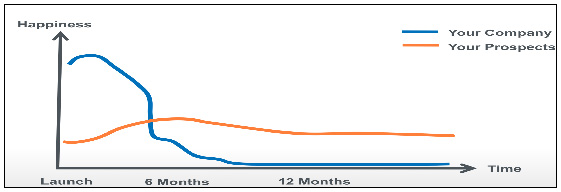Make sure your prospect or client is going into a redesign for the right reasons. You need to establish that website redesign is a continuous process, and just as much about functionality as it is design. The first thing they will need to do, along with your help, is set their redesign goals.
Key Concepts and Statistics

Website Redesign Half-Life Chart

Source: Hubspot, Webinar Redesign Strategy, 2010
- The excitement you and your CEO will have from a complete renovation of your website will be short lived.
- Once you have visited your site repeatedly, the excitement of a new website will turn into boredom.
- Complete website renovation is even worse for users.
- Users are accustomed to the constancy of old website.
- Need time to adjust, causing them more confusion.
Takeaway
Misguided reasons for redesigning your website are driven by the thought that the freshness and “wow factor” of a new website will increase excitement over your brand. The main motivations behind website renovations should be to improve the performance of your website. A beautiful website, although intriguing and aesthetically pleasing, is secondary to a functional traffic and lead generating website.
The Right, and Wrong Reasons, for Website Redesign
As we get ready to enter 2012, company execs and managers are sitting down to map out their New Year’s resolutions for their business marketing plan. Assessing what aspects of their marketing plans have worked in the last twelve months, which haven’t and what new tools and ideas have cropped up along the way. A new year tends to mean a new, or revamped branding direction, but does that always mean that a website redesign is a prerequisite?
To be frank, no. Despite the well-proven theory that the website stands as the hub for all online marketing efforts, companies looking to enhance their online marketing and brand-building efforts need not always start with a website redesign.
To Redesign, or Not to Redesign: Ask these Questions
When website redesign becomes a topic of conversation, ask yourself these questions:
“Do we want to get found by more prospects?”
“Do we want to convert more prospects into leads and eventually, customers?”
“Are we trying to improve branding?”
These are the three main reasons to pursue website redesign for any business. As the hub of the online marketing efforts, the website is ground zero for every ad, tweet, post, article or video posted online to reach a target market. If when prospects reach a website it doesn’t speak to their needs, in their terms, the conversion rates will easily reflect the failings. The content and graphic layout of any website works dually as the first impression of the brand and the sales pitch for the products and services to obtain leads or sales.
The same goes for the background of a site, the code from which it is built. SEO, search engine optimization, allows a website to be found organically when a prospect searches by keyword from the web. Website redesign takes the newest code and graphic options into consideration to ensure the site can be found by as much of a target market as possible.
Website redesign should be focused on garnering better ranking, increased brand awareness or enhanced lead generation; in other words, to build bottom line business return.
Website redesign should not be pursued as a fad to compete with other similar websites, to reflect a new look and feel you’ve added to your corporation, or if it’s been a year or two since the last redesign. A website is not an advertisement, it is a brand tool, and the consistency of that branding is as important as the viability of the products and services it represents.
So, as the discussion continues about 2012 online marketing efforts, goals to pursue website redesign should be driven by the performance of the website as well as a need to increase brand awareness or conversion rates. Businesses interested in these changes for the coming year need to be sure to make website redesign the top priority in their 2012 marketing efforts.